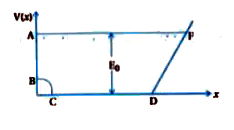Two inclined frictionless tracks , one gradual and the other steep meet at A from where two stones are allowed to slide down from rest , one on each track as shown in figure . Which of the following statement is correct ?
 Solution in Gujrati
Solution in Gujrati
Both the stones reach the bottom at the same time but not with the same speed
Both the stones reach the bottom with the same speed and stone I reaches the bottom earlier than stone II
Both the stones reach the bottom with the same apeed and stone II reaches the bottom earlier than stone I
Both the stones reach the bottom at different times and with different speeds .
The correct Answer is:C
K = U (Conservation of energy )
12mv2=mgh
v=√2gh
h is same for both stones ,hence v is same .
For stone - 1 , For stone -2 ,
a1=gsinθ1 a2=gsinθ2
a1<a2(∴θ1<θ2)
Hence ,stone II reaches earlier than stone I .
Topper's Solved these Questions
- WORK, ENERGY AND POWER BOOK - KUMAR PRAKASHANCHAPTER - WORK, ENERGY AND POWER EXERCISE - SECTION - D NCERT Exemplar Solutions (Very Short Answer Type Questions)
12 Videos
- WORK, ENERGY AND POWER BOOK - KUMAR PRAKASHANCHAPTER - WORK, ENERGY AND POWER EXERCISE - SECTION - D NCERT Exemplar Solutions (Short Answer Type Questions)
10 Videos
- WORK, ENERGY AND POWER BOOK - KUMAR PRAKASHANCHAPTER - WORK, ENERGY AND POWER EXERCISE - SECTION - C Objective Questions (VSQs)
52 Videos
- WAVESBOOK - KUMAR PRAKASHANCHAPTER - WAVESEXERCISE - SECTION-F (Questions From Module) (Sample questions for preparation of competitive exams)
23 Videos
Similar Questions
A through inclined is placed on car moving with a constant velocity u on horizontal ground . A block of mass M rests on the inclined plane . Is any work done by force of friction then a dissipation of energy ?
View SolutionA graph of potential energy V(x) verses x is shown in figure .A particle of energy E0 is executing motion in it . Draw graph of velocity and kinetic energy verses x for one complete cycle AFA.

View SolutionIf →A=2ˆi−2ˆjand→B=2ˆk then →A.→B……
View SolutionIn a standing wave formed by two atoms separated by 1.21Å, there are 3 nodes and 2 antinodes. Find its wavelength.
View SolutionTwo inclined frictionless tracks, one gradual and the other steep meet at O, from where two stones are allowed to slide down from rest, one on each track. Will the stones reach the bottom at the same time ? Will they reach there with the same speed ? Explain.
View SolutionTwo inclined frictionless tracks, one gradual and the other steep meet at a from where two stones are allowed to slide down from rest, one on each track as shown in Figure. Which of the following statement is correct ?
 .
.
View SolutionTwo inclined frictionless tracks , one gradual and the other sleep meet at A from where two stones are allowed to slide down from rest. One on each track as shown in figure. Which of the following statement is correct?

View SolutionTwo inclined frictionless tracks, one gradual and the other steep meet at A from where to stones are allowed to slide down from rest, one on each track (fig.) Will hte stones reach the bottom at the same time? Will they reach there with the same speed? Explain, given θ1=30∘, θ92)=60∘ and h=10m. What are the speeds and time taken by the two stones?

View SolutionA body is allowed to slide down a frictionless inclined track under gravity from a height of 10 cm . The track ends in a circular loop of diameter D. The body is just able to complete the circular track , then the diameter of the track will be
View SolutionTwo inclined frictionless tracks, one gradual and the other steep meet at A, from where two stones are allowed to slide down from rest, one on each track. Will the stones reach the bottom at the same time? Will they reach there with the same speed? Given theta_(1)=30^(@),theta_(2)=60^(@),h=10m . What are the speeds and time taken by the two stones?
View SolutionTwo inclined frictionless tracks, one gradual and other steep meet at 'A' from where two stones are allowed to slide down from rest, one on each track as shown in figure. The speed of two stones on reaching at bottom are v1andv2 respectively. v1&v2 are related as

View SolutionTwo inclined frictionless tracks, one gradual and the other steep meet at A from where two stones are allowed to slide down from rest, one on each track (Fig. 6.16). Will the stones reach the bottom at the same time? Will they reach there with the same speed? Explain. Given theta_(1)= 30^(@), theta_(2)= 60^(@)" and "h= 10m , what are the speeds and times taken by the two stones?
View SolutionTwo inclined frictionless tracks, one gradual and the other steep meet at A from where two stones are allowed to slide down from rest, one on each track (Fig. 6.16). Will the stones reach the bottom at the same time? Will they reach there with the same speed? Explain. Given theta_(1)= 30^(@), theta_(2)= 60^(@)" and "h= 10m , what are the speeds and times taken by the two stones?
View SolutionTwo inclined frictionless tracks, one gradual and the other steep meet at A from where to stones are allowed to slide down from rest, one on each track (fig.) Will hte stones reach the bottom at the same time? Will they reach there with the same speed? Explain, given theta_(1)=30^(@) , theta_92)=60^(@) and h=10m. What are the speeds and time taken by the two stones?
View Solutionदो घर्षणरहित झुके हुए पथ, जिनमें से एक तो क्रमिक (Gradual) तथा दूसरा एकदम ढालू (Steep) जो 4 पर मिलते हैं, जहाँ से दो पत्थरों को विरामावस्था से चित्रानुसार प्रत्येक पथ से एक को लुढ़काया जाता है। निम्न में से कौन-सा कथन सही है?

View Solution
